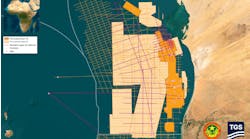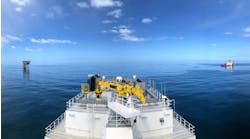Marshall DeLuca
International Editor
Subsalt celebrating crystal anniversary
In 1983, Placid Oil drilled the first of what was to eventuate into one of the most profitable trends in the Gulf of Mexico with it's #2 well in Ship Shoal 266. This well was the first in what was to become known as the Gulf of Mexico subsalt trend.
The Gulf of Mexico subsalt trend has become one of the most prolific plays in the offshore industry during its 15-year history. With vast potential in the size of the fields, relatively shallow water depths, and reservoirs close to existing infrastructure, subsalt offers operators enormous economic advantages.
In 1998, subsalt celebrated its "crystal" anniversary (15th) with the discovery of two major finds during a period when the industry was somewhat depressed. These discoveries, Tanzanite and Hickory, gave a breath of new life to the shallow water Gulf of Mexico. These discoveries have spurred more incentive than ever, especially to the smaller independents wishing to stay out of the expensive deepwater, to attack the subsalt trend.
However, subsalt, now a major play, almost began by accident. Many operators accidentally encountered subsalt while trying to probe areas thought to contain hydrocarbons. In fact, the Placid #2 well penetrated only 295 ft of subsalt structure. This thickness was not enough to confirm a major trend, but enough to spur interest from other operators and subsalt began to become a target.
- SMI 200: After the Placid discovery, the next step on the way to qualifying subsalt as a major play came in 1986 when Diamond Shamrock drilled the South Marsh Island 200 #1 well. This well encountered an 805-ft net thickness in a world-class reservoir-quality sand. However, the well still did not encounter hydrocarbon accumulations below the salt.
- Mickey: Four years later in 1990, subsalt hydrocarbons were finally struck with Exxon's Mississippi Canyon 211 #1 well in 4,300 ft of water. This identified the Mickey Field, which was estimated at 100-200 million bbl. However, due to the extreme water depth, the field is still awaiting development. This was considered the first truly significant subsalt discovery and encouraged more interest than ever into the region.
- Mahogany: While these wells encountered varying degrees of success, they still did not establish subsalt as a commercial trend. This designation came in late 1993 when Phillips and partners, Anadarko and Amoco, announced the discovery of the Mahogany Field with the #1 well and the successful appraisal well #2 in 1994. The Mahogany prospect is located in Ship Shoal 349 and has an estimated 100 million boe. The field is now producing from seven wells and is flowing 19,900 b/d of oil and 31 MMcf/d of gas. An eighth well is currently being drilled.
- Teak: With the Mahogany discovery and the oil industry in the upswing, subsalt leasing and drilling skyrocketed. Mahogany was soon followed by several key discoveries. These included a second major discovery from the Phillips-Anadarko partnership - Teak - in South Timbalier 260. Teak was not deemed commercial, but did flow 4,431 b/d of oil and 7.7 MMcf/d of gas and re-enforced the area's profitable potential.
- Enchilada: The next commercial discovery came in 1994 with the Shell, Pennzoil, and Amerada Hess Enchilada Field spanning blocks 127, 128, and 172 in Garden Banks. Enchilada tested at 2,100 b/d, 20 MMcf/d and has combined reserves estimated at 400 bcf of gas and 25 million bbl of oil/condensate. The field was brought onstream in July of last year, and marks the second producing subsalt well.
- Gemini: 1996 was proven to be the hottest year for subsalt with nine wells. Of these were three of major significance to re-affirming the trend: Gemini, Agate, and Monazite.
- Agate: Also in 1996, Andarko and Phillips struck twice. The companies discovered another field, Agate, in the Ship Shoal region. Well #1 in Ship Shoal 361 flowed a combined rate of 4,125 b/d of oil and 24 MMcf/d of gas from two zones. Agate is now producing into the Mahogany platform. Flow is currently 25 MMcf/d of gas and 2,500 b/d of condensate from one subsea completion. This marks the third producing subsalt well in the Gulf of Mexico.
- Monazite: A second strike in 1996, Monazite, came with partner BHP in Vermilion 375. Tests confirmed multiple hydrocarbon-bearing sands, but due to wellbore problems during testing, the well was plugged and abandoned. A 3D pre-stack depth migration and the drilling of appraisal wells were planned in late 1998, but no results have been released.
- Penn State: In late 1997, Amerada Hess and Oryx hit a major subsalt discovery in the deepwater of Garden Banks 216 with the #3 Penn State Deep well. The discovery was in 1,450 ft of water and located below the Penn State Shallow discovery made in 1996. The well cut 123 ft of net pay in four zones at about 20,500 ft. The companies plan a subsea tie-back from Penn State to nearby Baldpate in Garden Banks 260. The importance of this well was the re-affirmation of deepwater subsalt potential and its ability to be produced.
- Tanzanite: In 1998, the industry was entering another downturn and drilling on the shelf in the Gulf of Mexico looked bleak at best. But, in July Anadarko proved that the shallow water was not dead when it made the Tanzanite subsalt discovery which encountered a massive reservoir. Tanzanite is located in Eugene Island 346 and the first well tested 1,917 b/d of oil and 29.7 MMcf/d of gas, the highest flow rate ever achieved from an Anadarko-operated well, and one of the highest rates ever tested by industry in the shallow water of the Gulf of Mexico. The first well on Tanzanite was drilled to a TD of 14,350 ft in 314 ft of water and indicated a 1,000-acre productive reservoir with reserves estimated at 140 million boe. Development wells are currently underway as well as design and construction of a production platform. The platform is anticipated for installation late this year with initial production to begin in the third quarter of 2000.
- Hickory: Later in 1998 Anadarko further emphasized the subsalt trend with its second discovery - Hickory. Hickory is located in Grand Isle 116 in 320 ft of water. The well was drilled to 21,600 ft and encountered 300 ft of hydrocarbon pay in multiple sands. The well penetrated a salt section of about 8,000 ft, which is believed to be the thickest section of salt ever drilled in the Gulf. Current reserve projections are set at 40 million boe. Delineation wells are currently underway as well as design work on a production platform. First production is expected in late 2000.
Reference
Dwight "Clint" Moore - Anadarko Petroleum, Robert O. Brooks (retired) - TGS/Calibre Geophysical, Offshore - January, 1997.Copyright 1999 Oil & Gas Journal. All Rights Reserved.


